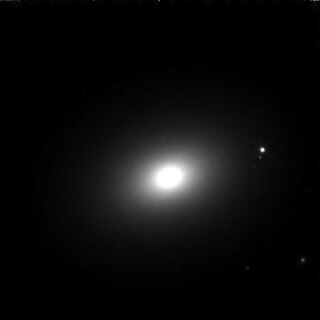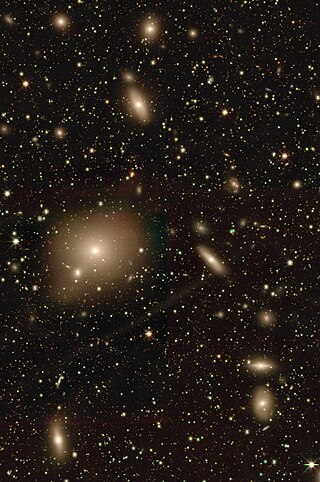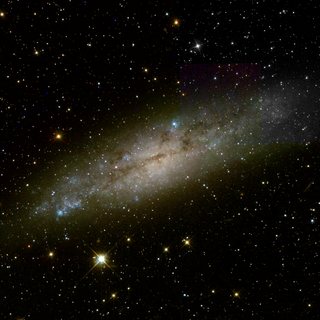
NGC 7002 is a large elliptical galaxy, and a radio galaxy, around 320 million light-years away from Earth in the constellation of Indus. The galaxy was discovered by English astronomer John Herschel on September 30, 1834. NGC 7002 is the brightest member of a group of galaxies known as [T2015] nest 200093. The group contains 12 member galaxies including NGC 7004, has a velocity dispersion of 440 km/s and an estimated mass of 1.28 × 1014M☉. NGC 7002 is also host to a supermassive black hole with an estimated mass of 2.7 × 109M☉.

NGC 7003 is a spiral galaxy around 220 million light-years from Earth in the constellation Delphinus. NGC 7003 has an estimated diameter of 85,000 light-years. The galaxy was discovered by German astronomer Heinrich Louis d'Arrest on August 26, 1864.

NGC 7004 is a lenticular galaxy and a type 2 Seyfert galaxy around 330 million light-years away from Earth in the constellation Indus. NGC 7004 has an estimated diameter of 140,000 light-years. NGC 7004 was discovered by astronomer John Herschel on October 2, 1834. NGC 7004 is a member of a group of galaxies known as [T2015] nest 200093. The group contains 12 member galaxies including NGC 7002, has a velocity dispersion of 440 km/s and an estimated mass of 1.28 × 1014M☉. NGC 7004 is also host to a supermassive black hole with an estimated mass of 8.1 × 108M☉.

NGC 7007 is a lenticular galaxy with a small bar, around 100 million light-years away from Earth in the constellation Indus. It was discovered by astronomer John Herschel on July 8, 1834. The galaxy is a type 2 seyfert galaxy, and is host to a supermassive black hole with an estimated mass of 4.9 × 107M☉.

NGC 7014 is an elliptical galaxy located about 210 million light-years away from Earth in the constellation Indus. NGC 7014 was discovered by English astronomer John Herschel on October 2, 1834. A population of around 1,634 known globular clusters surround the galaxy, and it is also host to a supermassive black hole with an estimated mass of 2.6 × 109M☉. NGC 7014 is also classified as a type 1 seyfert galaxy.

NGC 7015 is a spiral galaxy located about 203 million light-years away from Earth in the constellation Equuleus. NGC 7015's calculated velocity is 4,881 km/s (3,033 mi/s). NGC 7015 was discovered by French astronomer Édouard Stephan on September 29, 1878.

NGC 7019 is a spiral galaxy located about 480 million light-years away in the constellation of Capricornus. It was discovered by American astronomer Francis Leavenworth in 1886. It is host to a supermassive black hole with an estimated mass of with an estimated mass of 7.5 × 107M☉.

NGC 1436 is a barred spiral galaxy with LINER activity approximately 58 million light-years away from Earth in the constellation of Eridanus. NGC 1436 is a flocculent spiral galaxy lying almost face-on to the Earth. It is a member of the Fornax I cluster.

NGC 4596 is a barred lenticular galaxy located about 55 million light-years away in the constellation Virgo. NGC 4596 was discovered by astronomer William Herschel on March 15, 1784. NGC 4596 is a member of the Virgo Cluster and has an inclination of about 38°.

NGC 4709 is an elliptical galaxy located in the constellation Centaurus. It is considered to be a member of the Centaurus Cluster and is the dominant member of a small group of galaxies known as "Cen 45" which is currently merging with the main Centaurus Cluster even though the two subclusters' line of sight redshift velocities differ by about 1500 km/s. NGC 4709 was discovered by astronomer James Dunlop on May 7, 1826.

NGC 1281 is a compact elliptical galaxy located about 200 million light-years away in the constellation Perseus. NGC 1281 was discovered by astronomer John Dreyer on December 12, 1876. It is a member of the Perseus Cluster.

NGC 3860 is a spiral galaxy located about 340 million light-years away in the constellation Leo. NGC 3860 was discovered by astronomer William Herschel on April 27, 1785. The galaxy is a member of the Leo Cluster and is a low-luminosity AGN (LLAGN). Gavazzi et al. however classified NGC 3860 as a strong AGN which may have been triggered by a supermassive black hole in the center of the galaxy.

NGC 1892 is a spiral galaxy located approximately 51 million light-years away the constellation Dorado. It was discovered November 30, 1834 by John Herschel. NGC 1892 is a member of the NGC 1947 Group which is part of the Southern Supercluster.

NGC 753 is a spiral galaxy located 220 million light-years away in the constellation Andromeda. The galaxy was discovered by astronomer by Heinrich d'Arrest on September 16, 1865 and is a member of Abell 262.

NGC 4313 is an edge-on spiral galaxy located about 50 million light-years away in the constellation Virgo. It was discovered by astronomer William Herschel on March 15, 1784. NGC 4313 is a member of the Virgo Cluster and is classified as LINER and as a Seyfert galaxy.

NGC 1369 is a barred lenticular galaxy located 59 million light years away in constellation of Eridanus. The galaxy was discovered by astronomer Julius Schmidt on January 19, 1865, and is a member of the Fornax Cluster. NGC 1369 is a host to a supermassive black hole with an estimated mass of 1.8 million solar masses.

NGC 1428 is a peculiar galaxy of an uncertain morphology; either an elliptical or lenticular galaxy located approximately 65 million light-years away from Earth.

NGC 4393 is a spiral galaxy about 46 million light-years away in the constellation Coma Berenices. It was discovered by astronomer William Herschel on April 11, 1785. It is a member of the NGC 4274 Group, which is part of the Coma I Group or Cloud.

NGC 4328 is a nucleated dwarf elliptical or lenticular galaxy located about 48 million light-years away based on observations by the Hubble Space Telescope using the TRGB distance indicator. NGC 4328 was discovered on March 21, 1784 by astronomer William Herschel and is a member of the Virgo Cluster in the "A'' subgroup. On the sky, NGC 4328 is located in the constellation Coma Berenices.

NGC 4310 is a dwarf spiral galaxy with a dust lane and ring structure located about 54 million light-years away in the constellation Coma Berenices. It was discovered by astronomer William Herschel on April 11, 1785. It was rediscovered by astronomer Heinrich d'Arrest on May 19, 1863, and was later listed as NGC 4338. The galaxy is host to a supermassive black hole with an estimated mass of 107 solar masses.



















